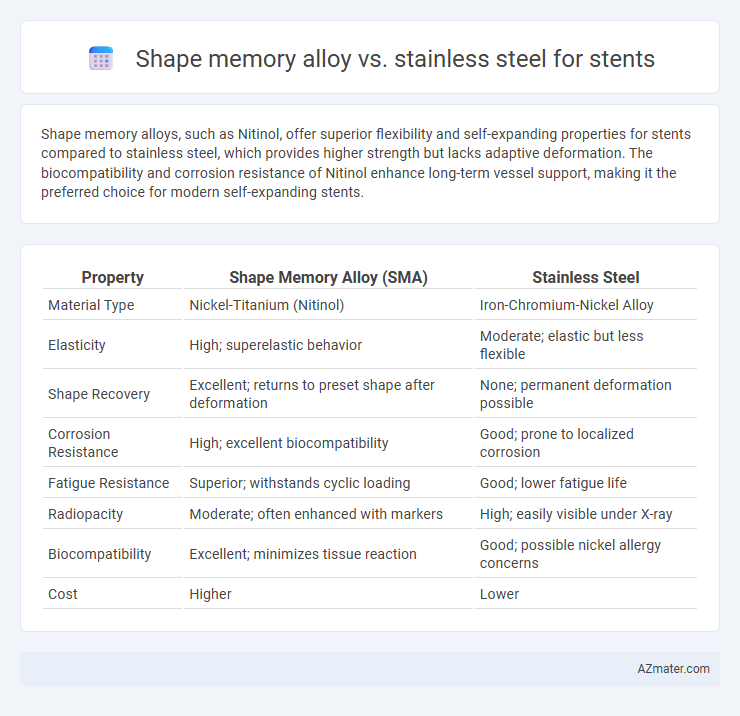Shape memory alloys, such as Nitinol, offer superior flexibility and self-expanding properties for stents compared to stainless steel, which provides higher strength but lacks adaptive deformation. The biocompatibility and corrosion resistance of Nitinol enhance long-term vessel support, making it the preferred choice for modern self-expanding stents.
Table of Comparison
| Property | Shape Memory Alloy (SMA) | Stainless Steel |
|---|---|---|
| Material Type | Nickel-Titanium (Nitinol) | Iron-Chromium-Nickel Alloy |
| Elasticity | High; superelastic behavior | Moderate; elastic but less flexible |
| Shape Recovery | Excellent; returns to preset shape after deformation | None; permanent deformation possible |
| Corrosion Resistance | High; excellent biocompatibility | Good; prone to localized corrosion |
| Fatigue Resistance | Superior; withstands cyclic loading | Good; lower fatigue life |
| Radiopacity | Moderate; often enhanced with markers | High; easily visible under X-ray |
| Biocompatibility | Excellent; minimizes tissue reaction | Good; possible nickel allergy concerns |
| Cost | Higher | Lower |
Introduction to Stent Materials
Shape memory alloys (SMAs), primarily nickel-titanium (Nitinol), are favored for stents due to their superelasticity and biocompatibility, enabling self-expansion at body temperature. Stainless steel, typically 316L grade, offers high strength and corrosion resistance but lacks the flexibility and recovery properties of SMAs. The choice between these materials impacts stent performance, with SMAs providing improved adaptability within dynamic vascular environments compared to rigid stainless steel.
Overview of Shape Memory Alloys
Shape memory alloys (SMAs), particularly nickel-titanium (Nitinol), exhibit unique superelastic and shape recovery properties that make them ideal for stent applications requiring flexibility and resilience within dynamic vascular environments. These alloys enable self-expanding stents that adapt to arterial movements, providing consistent radial force and reducing restenosis compared to stainless steel stents. In contrast, stainless steel stents offer higher rigidity but lack the adaptive mechanical behavior inherent to SMAs, often resulting in less optimal long-term vessel support.
Overview of Stainless Steel in Stents
Stainless steel is widely used in stents due to its excellent mechanical strength, corrosion resistance, and biocompatibility, making it reliable for vascular applications. Its non-ferromagnetic nature minimizes interference with medical imaging techniques like MRI, enhancing patient safety. Moreover, the material's ease of fabrication and cost-effectiveness contribute to its popularity in producing durable and flexible stents.
Mechanical Properties Comparison
Shape memory alloys (SMAs), such as Nitinol, exhibit superior elasticity and exceptional fatigue resistance compared to stainless steel, making them ideal for stents that require flexible and dynamic responses to arterial movements. Stainless steel offers higher tensile strength and stiffness but lacks the pseudo-elastic properties and recoverable deformation that allow SMAs to adapt to vascular environments without permanent deformation. The biocompatibility and corrosion resistance of SMAs also contribute to improved mechanical durability and reduced restenosis rates in stent applications.
Biocompatibility and Safety
Shape memory alloys, particularly nickel-titanium (Nitinol), exhibit superior biocompatibility due to their ability to conform to vascular structures and resist corrosion, reducing inflammatory responses and restenosis risk. Stainless steel, commonly used in stents, offers high mechanical strength but may provoke higher rates of allergic reactions and corrosion-related complications over time. The safety profile of shape memory alloys benefits from enhanced flexibility and fatigue resistance, minimizing vessel trauma and improving long-term patient outcomes compared to stainless steel stents.
Flexibility and Conformability
Shape memory alloys, particularly Nitinol, exhibit superior flexibility and conformability compared to stainless steel, allowing stents to adapt dynamically to vascular movements without compromising structural integrity. Stainless steel stents, while offering high radial strength, are inherently less flexible and conformable, potentially leading to vessel irritation or reduced adaptability in tortuous anatomies. The unique phase transformation properties of shape memory alloys enable shape recovery and enhanced vessel wall apposition, improving clinical outcomes in complex vascular environments.
Corrosion Resistance and Durability
Shape memory alloys, particularly nickel-titanium (Nitinol), exhibit superior corrosion resistance and enhanced durability compared to stainless steel when used for stents, due to their stable oxide layer and exceptional fatigue resistance. Stainless steel stents, while cost-effective and widely used, are prone to corrosion and metal ion release in physiological environments, potentially compromising long-term biocompatibility and structural integrity. The inherent elasticity and self-expanding properties of shape memory alloys provide improved mechanical performance and reduced restenosis risk, making them more reliable for durable cardiovascular implants.
Clinical Outcomes and Effectiveness
Shape memory alloys, particularly Nitinol, offer superior flexibility and self-expanding properties compared to stainless steel, enhancing stent deployment accuracy and reducing vessel trauma. Clinical outcomes demonstrate lower restenosis rates and improved endothelialization with shape memory alloy stents, contributing to better long-term vessel patency. Stainless steel stents, while providing high radial strength, show higher incidences of in-stent restenosis and thrombosis, impacting overall effectiveness in critical vascular interventions.
Cost and Manufacturing Considerations
Shape memory alloys, such as Nitinol, offer superior flexibility and biocompatibility for stents but typically incur higher material and manufacturing costs compared to stainless steel. Stainless steel stents benefit from well-established manufacturing processes, lower raw material expenses, and easier scalability, making them more cost-effective for mass production. However, the advanced processing techniques required for shape memory alloys, including precise heat treatments and laser cutting, contribute to increased production complexity and expenses.
Future Trends in Stent Material Innovation
Shape memory alloys, such as Nitinol, offer superior flexibility, biocompatibility, and self-expanding capabilities, making them ideal for next-generation stents compared to traditional stainless steel. Future trends emphasize developing hybrid materials that combine the elasticity of shape memory alloys with the corrosion resistance of stainless steel to enhance long-term performance and reduce restenosis rates. Advances in nanotechnology and surface coatings are driving innovations to improve endothelialization and drug elution, optimizing stent efficacy and patient outcomes.

Infographic: Shape memory alloy vs Stainless steel for Stent
 azmater.com
azmater.com